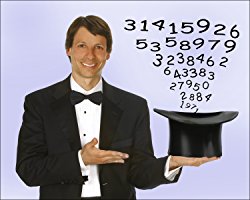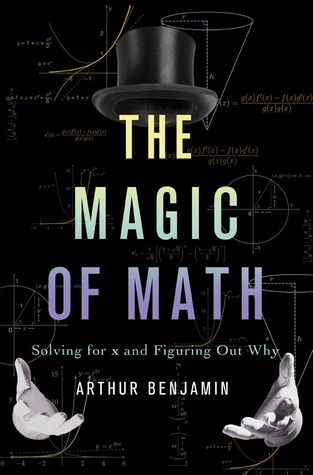The Magic of Math Summary
4 min read ⌚
 Solving for x and Figuring Out Why
Solving for x and Figuring Out Why
Oh No, I hate math! Hold your horses for a moment; this is more than just a brief introduction to mathematical calculations.
In this book summary, you’ll learn a few tricks; you can use to amuse your friends, and family.
Who Should Read “The Magic of Math”? And Why?
It may come as a surprise to you, but math can also be quite entraining; if you possess the right set of skills.
Don’t worry, no previous experience is required in order to utilize various numerical operations for personal gain.
“The Magic of Math” as the name implies, illustrates a brand-new revolution launched in the name of algorithmic and arithmetical functions.
We recommended to all “wizards” and those who want to join the club.
About Arthur Benjamin
 You may have heard of Arthur Benjamin, who regularly shares his findings as a hailed keynote speaker at Ted Talks.
You may have heard of Arthur Benjamin, who regularly shares his findings as a hailed keynote speaker at Ted Talks.
He obtained his Ph.D. from Johns Hopkins University.
“The Magic of Math Summary”
Mathematics is more than just a subject, boring or amusing to various groups of children. Calculations play an essential role in human development, and it’s fair to say, that magic can also be an integral part of its operations.
Take into account the “alchemy” of the well-known numerical patterns. In another case, these algorithms are labeled as patterns made of numbers. How do these features perform wizardry, regarding mathematics?
Well, you are not dealing with anything surreal, but with a well-proven concept that can improve your mental capacity and problem-solving skills.
For example, you don’t need any tool to calculate the square of a number quickly. In this book, you’ll find a detailed explanation of how to make that happen.
Stay with us to learn a few tricks and enlighten your friends and family. No, it’s not geeky; it’s magical if you really understand the trickery that revolves around math. Here are a few guidelines you must follow, in order to make your maneuver work:
-
- First, tell your friend/s to think of any two numbers between 1 and 10
-
- Afterward, you must add those numbers
-
- Next step would be to multiply the result by 10,
-
- Once you finished that, next in line is adding the larger number
-
- Then, subtract the smaller one
- and demand the final result.
Once, the “participant” successfully executes all the tasks, you (as a host) are just one step away from to knock your friend’s socks off by revealing the numbers he chose a few minutes ago.
Let’s divide the process, step by step: Let’s say that the final answer is 126. Next in line is separating the first two ciphers from the last digit. Here’s how it goes: Add the last number to the first two (6+12) and then divide this result by 2. 18/2= 9 – and this is the large number.
What comes next? It’s pretty straightforward to calculate the smaller number your friend picked. Just take this number (9) and subtract the last digit of the number, which emerged from the formula discussed earlier (126) = 9 – 6 = 3. It’s that simple!!
What is so special about the number 9? – Let’s dive right into it and unveil everything that contributes to the specialty of this digit.
In truth, not many people are aware of the facts that are partly responsible for making 9 too valuable to mathematicians. The first magic lies in the simplicity of multiple processes. 9, 18, 27, 36, 45, 54, 63, 72, 81, 90, 99, 108, 117, and so forth.
What’s so special about these digits? If you take a closer look, you’ll see that each of the digits in these numbers if added together will result in the same outcome = 9. For instance, (9+0), (8+1) (2+7) (4+5) … At first sight, many would assume that (9+9) destroys this sequence, but that’s not true.
18 – would still produce the same outcome if you add 1 and 8 once more.
At the beginning of the 13th century, a renowned Italian mathematician known as Fibonacci wrote a fantastic book that represents the point of no return in Math. The Book of Calculation or “Liber Abaci” marks the pivotal moment for solving arithmetic problems and displaying various formulas.
The operation exhibited through “Immortal rabbits” is perhaps the greatest piece of ingenuity that occurred in those days. What’s it all about? – From our basic understanding and rules, every month a little “r” (baby rabbit) converts into “R” (adult rabbit) and thus each “R” becomes “Rr.”
It means that now you have a pair of adults and a pair of babies.
So, what do we get?
-
- 1 Month – r
-
- 2 Month – R
-
- 3 Month – Rr
-
- 4 Month – Rr R
-
- 5 Month – Rr R Rr
- 6 Month – Rr R Rr Rr R
…
One can’t help but notice, that there is something weird about the end-result and the sequence generated from it.
At first glance, the digits – 1,1,2,3,5,8 … may seem irrelevant but scan it more thoroughly. What do you see? It’s pretty evident, that each number in the sequence is in fact, the sum of its two predecessors. For instance (1 + 2 = 3) (3 + 2 = 5) and so forth. This example represents the Fibonacci Numbers.
One thing separates math, from other branches of natural science – facts. Unlike other disciplines, mathematicians mainly focus on propositions, which can prove its absolute accuracy and relevance.
For instance, regardless of the circumstances or the intentions behind various equations, it’s 100% true to say that even numbers are multiples of 2. Therefore, it doesn’t take too much knowledge to realize that such assertation is validated.
Even famous mathematicians have their favorite ways of solving equations. A large portion of them would reply that eiπ+ 1 = 0 is one of their favorites.
Not only that it addresses different calculations, and it also includes the main five features of mathematics: 1, 0, π, i, and e.
Like this summary? We’d Like to invite you to download our free 12 min app, for more amazing summaries and audiobooks.
Our Critical Review
Are you a math lover? – You don’t have to be to like this book.
We sincerely enjoyed every bit of it and learned a few tricks along the road.
We advise that you should at least try to do the same because it’ll surely be a time well-spent.
Emir is the Head of Marketing at 12min. In his spare time, he loves to meditate and play soccer.


 Solving for x and Figuring Out Why
Solving for x and Figuring Out Why




